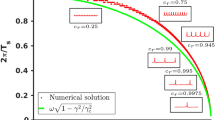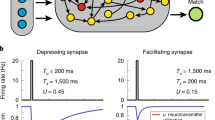Abstract
It has been proposed an abstract memory model of cortex that the recurrent network with inhibitory interneurons shows the successive retrieval of memories. It has not, however, been clarified whether such behavior appears in the realistic network model with the Hodgkin-Huxley type of neuron. By using the realistic model that consists of excitatory neurons and inhibitory interneurons, we here show that the successive retrieval of memories is also observed in the network of biologically-plausible model neurons.
Biologically, there is evidence for the involvement of acetylcholine (ACh) in attentional modulation and cholinergic projection decreases IPSPs in pyramidal neurons in layer 2/3 of the cerebral cortex.
Our simulation result shows that the coupling strength of inhibitory interneurons is very crucial for controlling the states of memory retrieval; all firing state, memory completion state and successive memory retrieval state. The field potential of the network in each state of memory retrieval has a specific frequency band. In this paper, we discuss the effects of the coupling strengths of inhibitory interneurons, the states of memory retrieval and the characteristics of frequency band in relation to the neurophysiological experimental data.
Access this chapter
Tax calculation will be finalised at checkout
Purchases are for personal use only
Similar content being viewed by others
References
Tsuda, I., Koerner, E., & Shimizu, H. (1987). Memory dynamics in asynchronous neural networks. Progress of Theoretical Physics, 78, 51–71.
Tsuda, I. (1992). Dynamic link of memory: chaotic memory map in nonequilibrium neural networks. Neural Networks, 5, 313–326.
Klausberger, T., Marton, L.F., Baude, A., Roberts, J.D.B., Magill, P. & Somogyi, P. (2004). Spike timing of dendrite-targeting bistratified cells during hippocampal network oscillations in vivo. Nat Neurosci, 7, 41–47.
Csicsvari, J., Hirase, H., Czurkó, A., Mamiya, A. & Buzsáki, G. (1999). Oscillatory coupling of hippocampal pyramidal cells and interneurons in the behaving rat. J. Neurosci, 19, 274–287.
Herrero, J.L., Roberts, M.J., Delicato, L.S., Gieselmann, M.A., Dayan, P. & Thiele, A. (2008). Acetylcholine contributes through muscarinic receptors to attentional modulation in V1. Nature 454, 1110–1114.
Toth, K., Freund, T. F. & Miles, R. (1997). Disinhibition of rat hippocampal pyramidal cells by GABAergic afferents from the septum. J. Physiol, 500, 463–474.
Salgado, H., Bellay, T., Nichols, J.A., Bose, M., Martinolich, L., et al. (2007). Muscarinic M2 and M1 receptors reduce GABA release by Ca2+ channel modulation through activation of PI3K/Ca2 + − independent and PLC/Ca2 + − dependent PKC. J. Neurophysiol, 98, 952–965.
Cape, E.G. & Jones, B.E. (1998). Differential modulation of high-frequency gamma –electroencephalogram activity and sleep-wake state by noradrenaline and serotonin microinjections into the region of cholinergic basalis neurons. J. Neurosci, 18, 2653–2666.
Dringenberg, H.C. & Vanderwolf, C.H. (1997). Neocortical activation: modulation by multiple pathways acting on central cholinergic and serotonergic systems. ExpBrain Res, 116, 160 –174.
Rodriguez, R., U. Kallenbach, W. Singer & M.H.J. Munk. (2004). Short- and long-term effects of cholinergic modulation on gamma oscillations and response synchronization in the visual cortex. J. Neurosci, 24, 10369–10378.
Fisahn, A., Pike, F.G., Buhl, E.H. & Paulsen, O. (1998). Cholinergic induction of network oscillations at 40 Hz in the hippocampus in vitro. Nature, 394, 186–189.
Buhl, EH., Tamás, G. & Fisahn, A. (1998). Cholinergic activation and tonic excitation induce persistent gamma oscillations in mouse somatosensory cortex in vitro. J. Physiol (London), 513, 117–126.
Pinsky, P. F. & Rinzel, J. (1994). Intrinsic and network rhythmogenesis in a reduced Traub model for CA3 neurons. Journal of Computational Neuroscience, 1, 39–60.
Wang, X.-J. & Buzsáki, G. (1996). Gamma oscillation by synaptic inhibition in a hippocampal interneuronal network model. J. Neurosci, 16, 6402–6413.
Acknowledgments
This work was supported by a Grant-in-Aid for Scientific Research on Innovative Areas “The study on the neural dynamics for understanding communication in terms of complex hetero systems (No.4103)” (21120002) of The Ministry of Education, Culture, Sports, Science, and Technology, Japan.
Author information
Authors and Affiliations
Corresponding author
Editor information
Editors and Affiliations
Rights and permissions
Copyright information
© 2013 Springer Science+Business Media Dordrecht
About this paper
Cite this paper
Tsukada, H., Yamaguti, Y., Fujii, H., Tsuda, I. (2013). Transitory Memory Retrieval in the Neural Networks Composed of Pinsky-Rinzel Model Neurons. In: Yamaguchi, Y. (eds) Advances in Cognitive Neurodynamics (III). Springer, Dordrecht. https://doi.org/10.1007/978-94-007-4792-0_91
Download citation
DOI: https://doi.org/10.1007/978-94-007-4792-0_91
Published:
Publisher Name: Springer, Dordrecht
Print ISBN: 978-94-007-4791-3
Online ISBN: 978-94-007-4792-0
eBook Packages: Biomedical and Life SciencesBiomedical and Life Sciences (R0)




